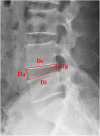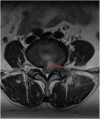Radiologic Analysis of Causes of Early Recurrence After Percutaneous Endoscopic Transforaminal Discectomy
- PMID: 35581748
- PMCID: PMC10676163
- DOI: 10.1177/21925682221096061
Radiologic Analysis of Causes of Early Recurrence After Percutaneous Endoscopic Transforaminal Discectomy
Abstract
Study design: Retrospective study.
Objective: To analyze the causes of and factors influencing early recurrence after TELD performed in the treatment of lumbar disc herniation.
Methods: We included 285 patients with single-segment lumbar disc herniation treated using transforaminal endoscopy lumbar discectomy TELD from January 2017 to December 2019 at the First Affiliated Hospital of the University of South China. Patients were classified into early recurrence and non-early recurrence groups based on clinical symptoms and MRI reexamination. Imaging data (eg, disc height index (DHI), Pfirrman grades, base width, postoperative annulus-fibrosus tear size, cross-sectional area of the foramen (CSAF), etc.)were analyzed, and multivariate, binomial logistic regression was utilized to determine which factors were associated with early recurrence after TELD.
Results: A total of 285 patients completed surgery and clinical follow-up, during which 19 patients relapsed within 6 months postsurgery, for an early recurrence rate of 6.7%. There were statistically significant differences between DHI, Pfirrman grades, base width, postoperative annulus-fibrosus tear size, herniation sites, CSAF and Modic changes between the early recurrence and non-early recurrence groups (P < .05). On multivariate logistic regression,the degree of disc degeneration (OR = .747, P = .037), CSAF (OR = 5.255, P = .006), degree of Modic change (OR = 1.831, P = .018) and base width of the herniation (OR = 4.942, P = .003) were significantly correlated with early recurrence after TELD.
Conclusions: Postoperative annulus-fibrosus tear size, DHI, and location of the disc herniation were associated with early recurrence after TELD. Increased base width of the herniation, severe disc degeneration, decreased CSAF and Modic change were risk factors for early recurrence after TELD.
Keywords: Early recurrence; Lumbar-disc herniation; Radiologic; Reherniation; transforaminal endoscopy lumbar discectomy.
Conflict of interest statement
Declaration of Conflicting InterestsThe author(s) declared no potential conflicts of interest with respect to the research, authorship, and/or publication of this article.
Figures






References
-
- Andersson GB. Epidemiological features of chronic low-back pain. Lancet. 1999;354(9178):581-585. - PubMed
-
- Ahn S, Kim S, Kim D, Lee B. Comparison of Outcomes of Percutaneous Endoscopic Lumbar Discectomy and Open Lumbar Microdiscectomy for Young Adults: A Retrospective Matched Cohort Study. World Neurosurg. 2016;86:250-258. - PubMed
-
- Ruan W, Feng F, Liu Z, Xie J, Cai L, Ping A. Comparison of percutaneous endoscopic lumbar discectomy versus open lumbar microdiscectomy for lumbar disc herniation: A meta-analysis. Int J Surg. 2016;31:86-92. - PubMed
-
- Choi KC, Kim JS, Park CK. Percutaneous Endoscopic Lumbar Discectomy as an Alternative to Open Lumbar Microdiscectomy for Large Lumbar Disc Herniation. Pain Physician. 2016;19:E291-300. - PubMed
-
- Sharma SB, Lin GX, Jabri H, et al. Radiographic and clinical outcomes of huge lumbar disc herniations treated by transforaminal endoscopic discectomy. Clin Neurol Neurosurg. 2019;185:105485. - PubMed
LinkOut - more resources
Full Text Sources

